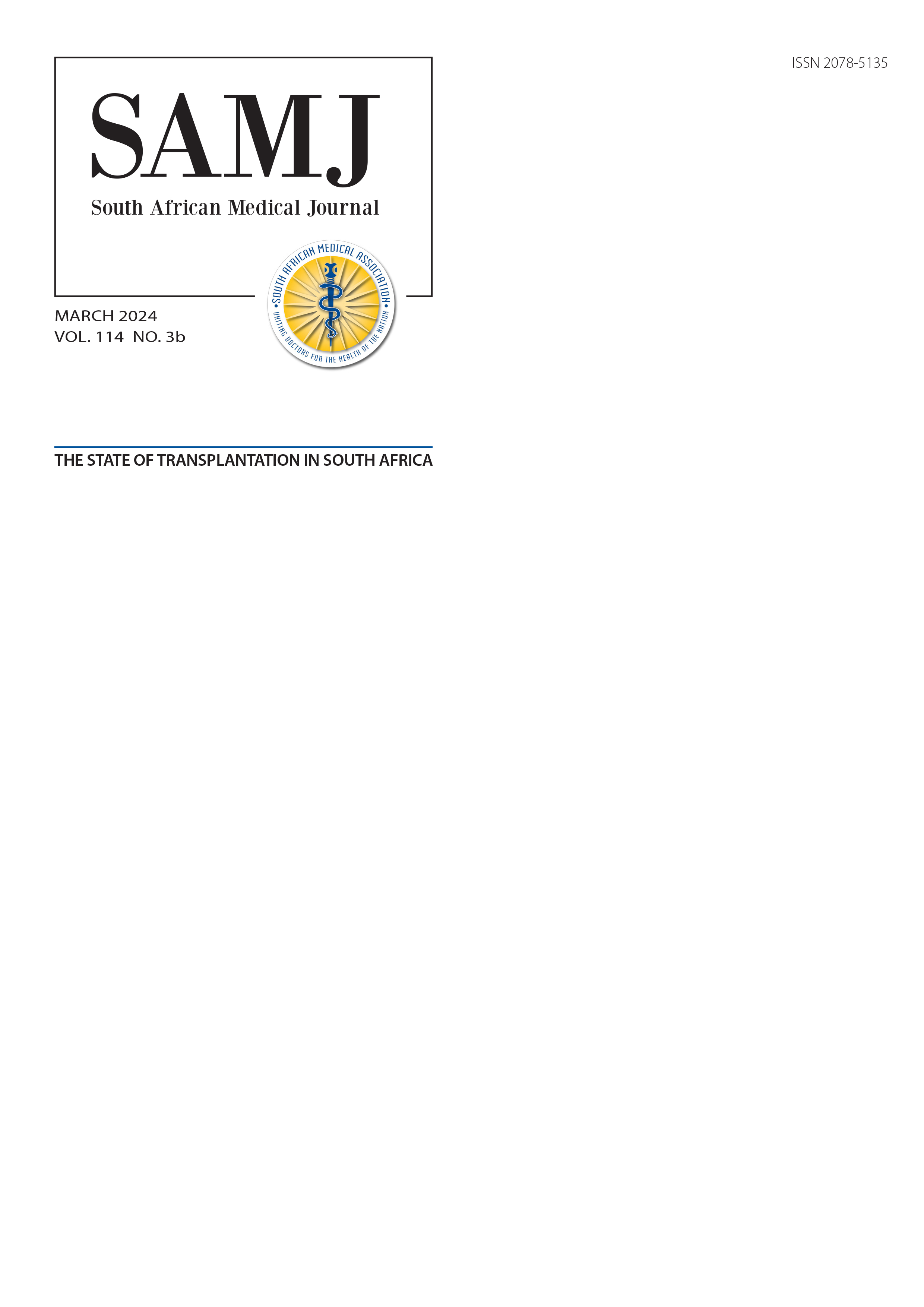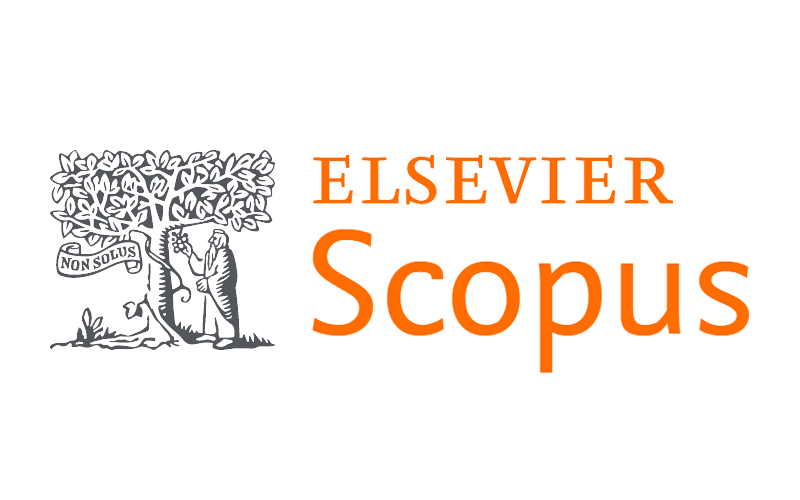A retrospective analysis of outcomes and complications of living- and deceased-donor split-liver transplantation in Johannesburg, South Africa
DOI:
https://doi.org/10.7196/SAMJ.2024.v114i3b.1366Keywords:
liver transplant, Deceased donor organs, Split Liver, Liver Failure, Living DonorsAbstract
Background. South African transplant centres are faced with significant challenges in meeting the need for liver transplantation, owing to the low and ever-decreasing number of deceased-donor organs. To increase organ utility, deceased-donor split-liver transplant (DDSLT) and living-donor liver transplant (LDLT) programmes were initiated in the Wits Transplant Unit.
Objective. To evaluate outcomes of the LDLT and DDSLT programmes.
Methods. A retrospective analysis of de-identified recipient and donor variables from all adult and paediatric DDSLTs and LDLTs conducted between 2013 and 2021 was performed. Comparison of categorical study variables between graft types was done with the χ2 test. Continuous variables were compared by means of the independent samples t-test. Cox proportional hazards regression was performed to examine the effect of graft type on recipient and graft survival. All comparisons were made unadjusted, and adjusted for recipient age, recipient ethnicity, donor sex, and graft-weight-to-recipient-weight ratio (GWRWR) (for the paediatric cohort); and for donor age and GWRWR (for the adult cohort).
Results. A total of 181 paediatric and 48 adult liver transplants have been performed since the inception of the two programmes. Chronic liver failure, specifically intra- and extrahepatic cholestatic disease, was our main indication for liver transplantation in both cohorts. There were no significant differences between the DDSLTs and LDLTs in respect of pre- or post-discharge intervention, in-hospital mortality, length of stay, and recipient or graft survival within both the paediatric and adult groups. Our overall 1- and 3-year survival estimates (95% confidence intervals) were 77% (70% - 83%) and 71% (64% - 78%) for the paediatric cohort, and 77% (62% - 87%) and 66% (50% - 78%) for the adult cohort, respectively.
Conclusion. The results of this study demonstrate comparable outcomes between DDSLT and LDLT, indicating that both methods are effective approaches to optimise organ utilisation for liver transplantation within our setting.
References
GurakarA,DoganS.Livertransplantationupdate:2014.EuroasianJHepatogastroenterol2015;5(2):98- 106. https://doi.org/10.5005/jp-journals-10018-1144
GurakarA.Livertransplantationindevelopingcountries.HepatolForum2022https://hepatologyforum. org/article/97 (accessed 24 January 2022).
Emre S, Umman V. Split liver transplantation: An overview. Transplant Proc 2011;43(3):884-887.
https://doi.org/10.1016/j.transproceed.2011.02.036
Du Toit T, Manning K, Thomson D, McCurdie F, Muller E. A 10-year analysis of organ donor referrals to a South African tertiary public sector hospital. S Afr Med J 2020;110(2):132-134. https://doi. org/10.7196/SAMJ.2020.v110i2.14125
Spearman CWN, McCulloch M, Millar AJW, et al. Liver transplantation at Red Cross War Memorial Children’s Hospital. S Afr Med J 2006;96(9Pt2):960-963).
Loveland J, Britz R, Joseph C, et al. Paediatric liver transplantation in Johannesburg revisited: 59 transplants and challenges met. S Afr Med J 2014;104(11Pt2):799-802. https://doi.org/10.7196/ SAMJ.8627
Spada M, Riva S, Maggiore G, Cintorino D, Gridelli B. Pediatric liver transplantation. World J Gastroenterol 2009;15(6):648. https://doi.org/10.3748/wjg.15.648
WanP,YuX,XiaQ.Operativeoutcomesofadultlivingdonorlivertransplantationanddeceaseddonor liver transplantation: A systematic review and meta-analysis: LDLT versus DDLT in adult patients. Liver Transpl 2014;20(4):425-436. https://doi.org/10.1002/lt.23836
LeeJG,LeeK-W,KwonCHG,etal.Donorsafetyinlivingdonorlivertransplantation:TheKoreanOrgan Transplantation Registry Study. Liver Transpl 2017;23(8):999-1006. https://doi.org/10.1002/lt.24778.
Olthoff KM, Smith AR, Abecassis M, et al. Defining long-term outcomes with living donor liver
transplantation in North America. Ann Surg 2015;262(3):465-475. https://doi.org/10.1097/
SLA.0000000000001383
Shukla A, Vadeyar H, Rela M, Shah S. Liver transplantation: East versus west. J Clin Exp Hepatol 2013;3(3):243-253. https://doi.org/10.1016/j.jceh.2013.08.004
Botha J, Ströbele B, Loveland J, et al. Living donor liver transplantation in South Africa: The donor experience. S Afr J Surg 2019;57(3):11-16. https://doi.org/10.17159/2078-5151/2019/v57n3a2998
Harris PA, Taylor R, Thielke R, Payne J, Gonzalez N, Conde JG. Research electronic data capture (REDCap): A metadata-driven methodology and workflow process for providing translational research informatics support. J Biomed Inform 2009;42(2):377-381. https://doi.org/10.1016/j.jbi.2008.08.010
HarrisPA,TaylorR,MinorBL,etal.TheREDCapconsortium:Buildinganinternationalcommunityof software platform partners. J Biomed Inform 2019;95:103208. https://doi.org/10.1016/j.jbi.2019.103208
Collett D. Modelling survival data in medical research. 3rd ed. Boca Raton: CRC Press, Taylor & Francis Group, 2015. ISBN 978-1-4398-5678-9
Bouter C, Britz R, Strobele B, et al. Adult and paediatric liver transplantation: Wits Transplant Data 2020. Wits J Clin Med 2023;5(1):41. https://doi.org/10.18772/26180197.2023.v5n1a6
Terrault NA, Francoz C, Berenguer M, Charlton M, Heimbach J. Liver transplantation 2023: Status report, current and future challenges. Clin Gastroenterol Hepatol 2023;S1542356523002781. https:// doi.org/10.1016/j.cgh.2023.04.005
Abu-Gazala S, Olthoff KM. Current status of living donor liver transplantation in the United States. Annu Rev Med 2019;70(1):225-238. https://doi.org/10.1146/annurev-med-051517-125454
Gad EH, Sallam AN, Soliman H, et al. Pediatric living donor liver transplantation (LDLT): Short- and long-term outcomes during sixteen years period at a single centre: A retrospective cohort study. Ann Med Surg 2022;79:103938. https://doi.org/10.1016/j.amsu.2022.103938
Dalzell C, Vargas PA, Soltys K, et al. Living donor liver transplantation vs. split liver transplantation using left lateral segment grafts in pediatric recipients: An analysis of the UNOS database. Transpl Int 2022;35:10437. https://doi.org/10.3389/ti.2022.10437
Gavriilidis P, Tobias A, Sutcliffe RP, Roberts KJ. Survival following right lobe split graft, living- and deceased-donor liver transplantation in adult patients: A systematic review and network meta-analysis. Transpl Int 2018;31(10):1071-1082. https://doi.org/10.1111/tri.13317
FisherRA,CotterellAH,MalufDG,etal.Adultlivingdonorversusdeceaseddonorlivertransplantation: A 10-year prospective single center experience. Ann Hepatol 2009;8(4):298-307. https://doi.org/10.1016/ S1665-2681(19)31742-9
KimTW,RobertsJ,StrudlerA,TayurS.Ethicsofsplitlivertransplantation:Shouldalargeliveralwaysbe split if medically safe? J Med Ethics 2022;48(10):738-741. https://doi.org/10.1136/medethics-2021-107400
Hong JC, Yersiz H, Farmer DG, et al. Longterm outcomes for whole and segmental liver grafts in adult and pediatric liver transplant recipients: A 10-year comparative analysis of 2,988 cases. J Am Coll Surg
;208(5):682-689. https://doi.org/10.1016/j.jamcollsurg.2009.01.023
Downloads
Published
Issue
Section
License
Copyright (c) 2024 R Crawford, J Loveland, P Gaylard, J Fabian, K Kinandu, B Bobat, A Mahomed, D Parbhoo, M Beretta, S Berkenfeld, S Rambarran, F van der Schyff, L Brannigan, B Strobele

This work is licensed under a Creative Commons Attribution-NonCommercial 4.0 International License.
Licensing Information
The SAMJ is published under an Attribution-Non Commercial International Creative Commons Attribution (CC-BY-NC 4.0) License. Under this license, authors agree to make articles available to users, without permission or fees, for any lawful, non-commercial purpose. Users may read, copy, or re-use published content as long as the author and original place of publication are properly cited.
Exceptions to this license model is allowed for UKRI and research funded by organisations requiring that research be published open-access without embargo, under a CC-BY licence. As per the journals archiving policy, authors are permitted to self-archive the author-accepted manuscript (AAM) in a repository.
Publishing Rights
Authors grant the Publisher the exclusive right to publish, display, reproduce and/or distribute the Work in print and electronic format and in any medium known or hereafter developed, including for commercial use. The Author also agrees that the Publisher may retain in print or electronic format more than one copy of the Work for the purpose of preservation, security and back-up.





